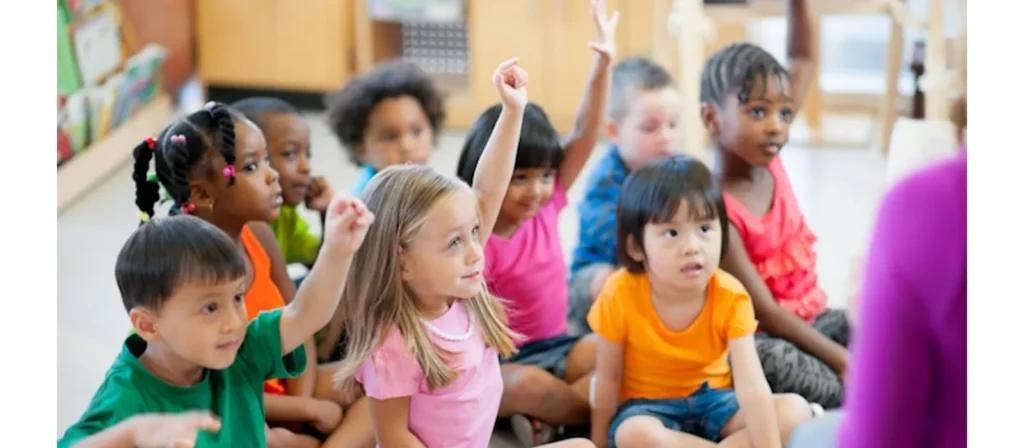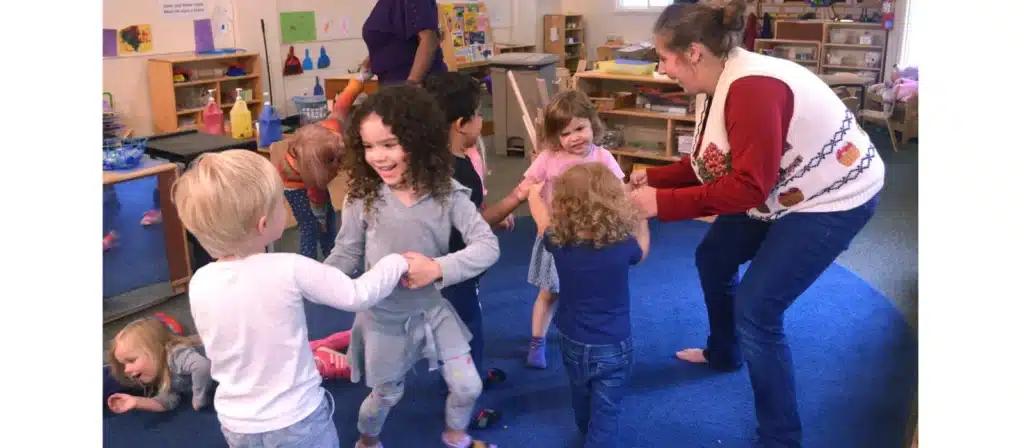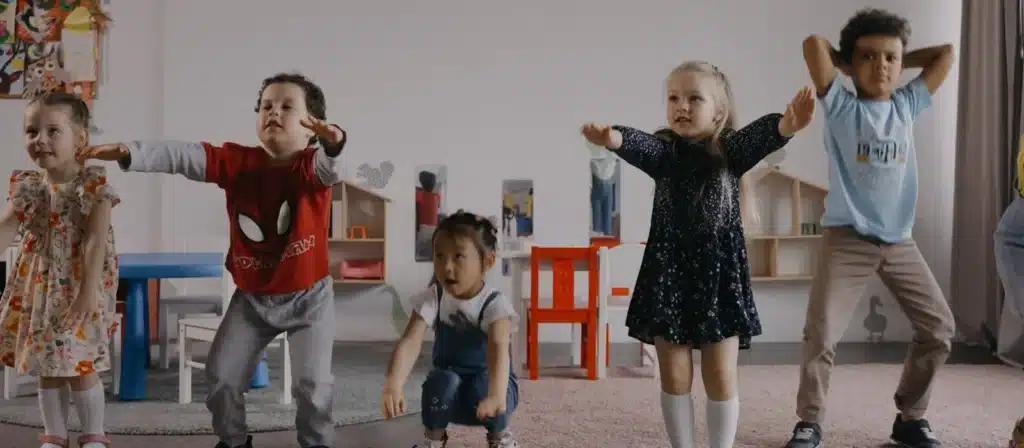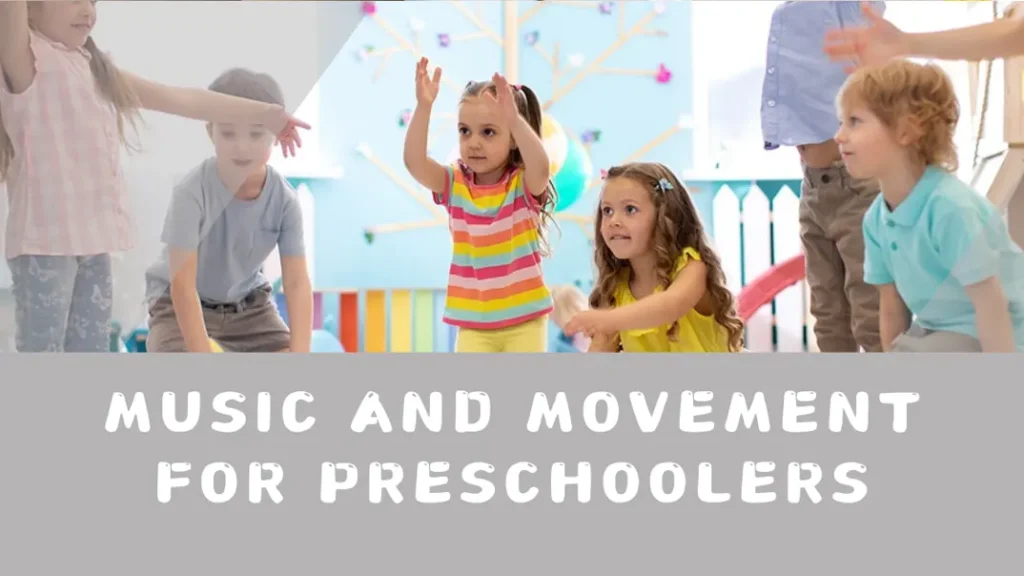Parenting can be challenging, especially when finding fun and educational activities for young children. Music and movement for preschoolers may be the answer you want. Music has long been recognized as a powerful tool for learning and growth, and when combined with movement, it becomes even more impactful!
Music and movement for preschoolers promote cognitive development, improve physical skills, and foster social and emotional growth. Engaging children in these activities creates a holistic learning experience that stimulates all aspects of their development.
Not only will your little one enjoy dancing and singing along to their favorite tunes, but they will also learn valuable concepts.
We’ll also provide practical tips and activity ideas for parents, educators, and caregivers to make the most of these enriching experiences. Prepare to embark on a journey filled with rhythm, dance and endless possibilities!
What is Music and Movement for Preschoolers?
Music and movement refer to activities that combine musical elements with physical movement. These can include singing, dancing, clapping, playing instruments, and other rhythmic activities that engage children in active participation. These activities are designed to be enjoyable and stimulate various developmental domains, including cognitive, physical, social, and emotional growth.
Combining music and movement helps children better understand rhythm and coordination. It makes learning more interactive and fun, enhancing a child’s engagement and retention of new information. This combination also provides a multisensory experience crucial for young children’s learning.
Why Are Music and Movement Important for Preschoolers?
According to Millersville University, music is instrumental in creating structured classroom routines and easing transitions.
Music and movement activities play a crucial role in the overall development of preschoolers. They provide a foundation for various skills and help children in numerous ways.
1. Support the Development of Motor Skills
Children who engage in activities such as dancing, clapping, and playing musical instruments improve their fine and gross motor skills. These activities enhance coordination, balance, and overall physical fitness, laying a foundation for more complex movements in the future.
2. Promote Language Development
Music is a powerful tool for language development. Songs with repetitive lyrics and catchy tunes help children expand their vocabulary, improve pronunciation, and develop listening skills. Engaging in singing activities can also enhance a child’s ability to understand and use language effectively.
3. Improve Social-Emotional Skills
Music and movement activities provide opportunities for children to interact with their peers, essential for developing social-emotional skills. Participating in group activities, such as singing in a choir or dancing in a group, teaches children important social skills like cooperation, turn-taking, and empathy.
4. Encourage Creativity
Creativity is vital to a child’s development, and music and movement are excellent ways to foster it. Encouraging children to create their dance moves or new song lyrics allows them to think creatively and experiment with different forms of expression.
5. Emotional Expression and Management
Music and movement provide a healthy outlet for children to express and manage their emotions. Dancing to music or playing an instrument can help children release pent-up energy and emotions, improving mood and emotional regulation.
6. Reading and Vocabulary Skills
Engaging in music and movement activities can also support the development of reading and vocabulary skills. Songs often contain rich language and storytelling elements that can enhance a child’s literacy skills.

Types of Music and Movement Activities for Preschoolers
When it comes to incorporating music and movement activities into preschool settings, the possibilities are endless. Various activities can cater to preschoolers’ different interests, learning styles, and developmental needs. Educators and caregivers can choose from various activities to engage children in creative and physical expression, from structured music classes to spontaneous dance sessions.
Music and Movement Games
These games involve singing, dancing, and playing instruments playfully and interactively. Games like “Musical Chairs,” “Freeze Dance,” and “Simon Says” not only entertain children but also help them develop listening skills, follow instructions, and practice coordination. Incorporating these games into daily routines can make learning fun and engaging for preschoolers.
Dance and Movement Exploration
Children can express themselves in these activities by exploring dance styles, rhythms, and movements. Dance sessions can be themed around animals, nature, or storytelling, allowing children to use their imagination and creativity while improving their coordination and motor skills. Encouraging children to dance freely and creatively fosters self-expression and confidence.
Music and Movement Storytelling
Storytelling through music and movement involves combining music, movement, and storytelling to create a multisensory experience for children. Educators can use musical instruments, props, and body movements to enhance storytelling sessions, making stories come alive dynamically and interactively.

Tips for Incorporating Music and Movement Into Daily Preschool Routines
Incorporating music and movement into daily preschool routines can be a rewarding experience for both children and educators. By infusing these activities into everyday schedules, educators can create a dynamic and engaging learning environment that supports children’s holistic development. Here are some tips for incorporating music and movement into daily preschool routines:
- Create a music-rich environment: Surround children with various musical instruments, recordings, and props to stimulate their interest in music. Play different genres of music, sing songs, and encourage children to explore sounds and rhythms independently.
- Integrate movement breaks: Incorporate short movement breaks throughout the day to help children release energy, refocus their attention, and engage their bodies. Encourage children to stretch, dance, or perform simple exercises to keep them active and alert.
- Use music for transitions: Utilize music to signal transitions between activities, such as clean-up time, circle time, or outdoor play. Select upbeat, rhythmic songs to motivate children to move from one task to another smoothly and effectively.
- Encourage creative expression: Provide opportunities for children to express themselves creatively through music and movement. Allow them to improvise movements, create their dances, and experiment with different musical instruments to foster their creativity and self-expression.
- Incorporate music and movement into learning activities: Infuse music and movement into various learning activities to make them more engaging and interactive. Use music to teach concepts like counting, alphabet recognition, and storytelling, and encourage children to move their bodies in response to music to reinforce learning.
- Celebrate cultural diversity: Explore music and movement traditions from different cultures and countries to help children develop an appreciation for diversity and multiculturalism. Introduce children to music styles, dances, and instruments worldwide to broaden their cultural awareness and understanding.

Music and Movement Activities for Specific Learning Objectives in Preschool
Music and movement activities can be tailored to address specific learning objectives in preschool and support children’s development across different domains. By aligning music and movement experiences with learning goals, educators can create purposeful and meaningful activities that engage children, reinforce key concepts, and enhance their skills and knowledge. Here are some examples of music and movement activities for specific learning objectives in preschool:
- Mathematics: Use music and movement activities to teach mathematical concepts such as counting, patterns, and shapes. Encourage children to clap, stomp, or move in patterns to reinforce numerical sequences, explore geometric shapes through dance movements, and create rhythmic patterns using body percussion.
- Language and literacy: Integrate music and movement into language and literacy activities to promote vocabulary development, phonemic awareness, and storytelling skills. Sing songs with rhyming words, use body movements to act out stories, and create sound patterns to enhance children’s language comprehension and communication skills.
- Science and nature: Explore scientific concepts and natural phenomena through music and movement activities. Use music to mimic natural sounds, create rhythmic patterns inspired by weather patterns, and dance to represent animal movements. These activities help children connect with the natural world, develop curiosity about science, and foster a sense of wonder and exploration.
- Social-emotional development: Incorporate music and movement activities that promote social-emotional skills such as empathy, self-regulation, and conflict resolution. Engage children in group dances that emphasize cooperation and teamwork, use music to calm and soothe emotions, and encourage children to express their feelings through creative movement. These activities support children’s emotional well-being, interpersonal relationships, and self-awareness.
- Cultural awareness: Introduce children to music and movement traditions from diverse cultures to cultivate cultural awareness and appreciation. Explore traditional dances, music styles, and instruments from different countries, and encourage children to participate in multicultural music experiences. These activities broaden children’s perspectives, foster respect for cultural diversity, and promote inclusivity and global citizenship.
Educators can create meaningful and impactful experiences that cater to children’s diverse needs, interests, and developmental goals by designing music and movement activities that align with specific learning objectives.

Resources and Tools for Music and Movement Activities in Preschool
Implementing music and movement activities in a preschool setting requires access to resources and tools that support children’s engagement and learning. Educators and caregivers can utilize various resources to enhance preschoolers’ music and movement experiences, including musical instruments, props, recordings, and educational materials. Here are some resources and tools that can aid in the implementation of music and movement activities in preschool:
- Musical instruments: Provide a diverse collection of musical instruments, such as drums, shakers, bells, and xylophones, for children to explore and play. Instruments of different sizes, shapes, and sounds can enrich children’s musical experiences and encourage creativity and experimentation.
- Props and visuals: Use props and visuals, such as scarves, ribbons, hoops, and pictures, to enhance music and movement activities. Props can add sensory stimulation, visual appeal, and storytelling elements to musical experiences, making them more interactive and engaging for children.
- Music recordings and playlists: Curate a selection of music recordings and playlists that cater to children’s interests, developmental levels, and learning objectives. Choose age-appropriate music that is diverse in genres and styles and conducive to movement and dance to create a stimulating musical environment for preschoolers.
- Educational books and materials: Incorporate educational books, posters, and materials that introduce children to musical concepts, instruments, and genres. Use visual aids and hands-on materials to reinforce learning, spark curiosity, and deepen children’s understanding of music and movement.
- Online resources and apps: Explore online resources, websites, and educational apps that offer interactive music and movement activities for preschoolers. Platforms that provide virtual music lessons, dance tutorials, and creative music-making tools can supplement in-person learning and expand children’s exposure to diverse musical experiences.
14 Best Music and Movement Activities for Preschoolers
1. Sing and Dance
Singing and dancing are fundamental music and movement activities that preschoolers love. Choose simple, repetitive songs that allow children to follow along easily. Songs like “The Wheels on the Bus” or “Head, Shoulders, Knees, and Toes” are great for this. Encourage children to make up their dance moves to the music.
2. Instrument Exploration
Instruments like tambourines, maracas, and xylophones can introduce children to different sounds and rhythms. This activity also helps in developing their motor skills and hand-eye coordination.
3. Freeze Dance
Freeze dance is a fun activity that helps children develop self-control and listening skills. Play music and let the children dance freely. When the music stops, they must freeze in their position until the music starts again. This game can be played with any type of music.
4. Musical Chairs
Musical chairs is a classic game that incorporates music and movement. Arrange chairs in a circle, one less than the number of participants. As the music plays, children walk around the chairs. When the music stops, they must quickly find a seat. The one left standing is out, and a chair is removed each round.
5. Animals in Action
This activity combines movement and imagination. Play music and ask the children to move like different animals. For example, they might hop like a frog, slither like a snake, or flap their arms like a bird.
6. March to the Beat
Marching to the beat of a drum or any rhythmic music can help children understand rhythm and timing. This activity is simple yet effective in improving coordination and musical awareness. Use different tempos to challenge the children’s ability to keep up with the rhythm.
7. Body Parts Dance
This dance activity focuses on body awareness. Play a fun song and call out different body parts for the children to move, such as “wiggle your fingers,” “shake your hips,” or “stomp your feet.”
8. Tissue Dance
Give each child a tissue and play some music. The goal is to keep the tissue in the air by blowing or moving it with their hands without letting it fall to the ground.
9. Musical Statue
In this game, children dance to music and freeze like statues when the music stops. It’s similar to freeze dance but with the added challenge of holding a pose. This activity helps improve balance and control while providing lots of fun.
10. Wear a Scarf and Dance to Classical Music
Give each child a scarf and play some classical music. Encourage them to move the scarf in time with the music. This activity helps children appreciate different genres of music while developing their sense of rhythm and coordination.
11. Dance Party
Organize a dance party with various music styles. Allow the children to dance freely and express themselves. This is a great way to let them burn off energy and develop their social skills as they interact with their peers.
12. Outdoor Nature Walk
Take the children on a nature walk and incorporate music by singing songs about nature or playing instruments made from natural materials like sticks and stones.
13. Feather Dance
Give each child a feather and play some gentle music. The aim is to keep the feather floating in the air by blowing on it or moving it gently. This activity is calming and helps develop fine motor control and breath regulation.
14. Yoga Song for Kids
Combine music and yoga by playing a song that guides children through simple poses. This activity promotes flexibility, balance, and mindfulness while incorporating musical elements to make it more engaging.
Preschool Movement Songs
Movement songs are essential in any preschool setting because they blend fun with learning and help children develop motor skills, coordination, and a love of music. Here are some popular sports songs.
1. Head, Shoulders, Knees, and Toes
“Head, Shoulders, Knees, and Toes” is a classic that has been around for generations. This song is perfect for teaching children the names of different body parts. The song starts slowly, allowing children to learn the movements and the words. As the song progresses, it gets faster, which adds an element of fun and excitement.
2. If You’re Happy and You Know It
This song is excellent for promoting emotional expression and physical activity. Each verse of the song encourages children to perform a different action, such as clapping their hands, stomping their feet, or shouting, “Hurray!”
This song helps children follow instructions and recognize different emotions. It can also be modified to include actions relevant to the lesson or theme of the day. The cheerful melody and simple lyrics make it easy for children to join and enjoy the activity.
3. The Hokey Pokey
“The Hokey Pokey” is a fun and interactive song that gets children moving in a circle. The song involves putting different body parts in a circle, shaking them, and turning around.
4. Shake Your Sillies Out
“Shake Your Sillies Out” is a high-energy song perfect for getting kids up and moving. The song encourages children to shake, clap, and jump, helping them burn off excess energy and get ready to focus on more structured activities. This song is particularly useful after a long sitting or during transition times.
5. I’m a Little Teapot
The song is short and sweet, which makes it perfect for holding the attention of young children. The actions of tipping over like a teapot are easy for preschoolers to mimic, helping them improve their balance and coordination.
6. Wheels on the Bus
“The Wheels on the Bus” is a favorite among preschoolers due to its repetitive lyrics and engaging actions. Each verse of the song describes different parts of the bus and their movements, such as the wheels going round and round, the wipers swishing, and the doors opening and closing.
7. Five Little Monkeys
“Five Little Monkeys” is a fun counting song that includes a lot of jumping and movement. The song tells the story of five little monkeys jumping on the bed and falling off individually. It helps children practice counting backward and understand the consequences of their actions in a playful way.
8 Row, Row, Row Your Boat
“Row, Row, Row Your Boat” is a gentle song that combines singing with a simple rowing motion. Children can sit in pairs or small groups and pretend to row a boat together. This activity encourages teamwork and coordination, as children must work together to move in sync.
Conclusion
Music and movement for preschoolers play an important role in education, providing multiple benefits that support children’s cognitive, physical, emotional, and social development. Educators can create a rich and stimulating learning environment that fosters children’s creativity, self-expression, and overall well-being by integrating music and movement into daily life.
When children engage in music and movement activities, they develop essential skills such as memory, attention, coordination, and social interaction. These activities enhance children’s academic readiness and instill a sense of joy, confidence, and resilience that can benefit them in all areas of life. By incorporating music and movement for preschoolers as an integral part of early childhood education, educators can build a strong foundation for children’s overall development and create a lasting impact that resonates throughout their educational journey and beyond.













